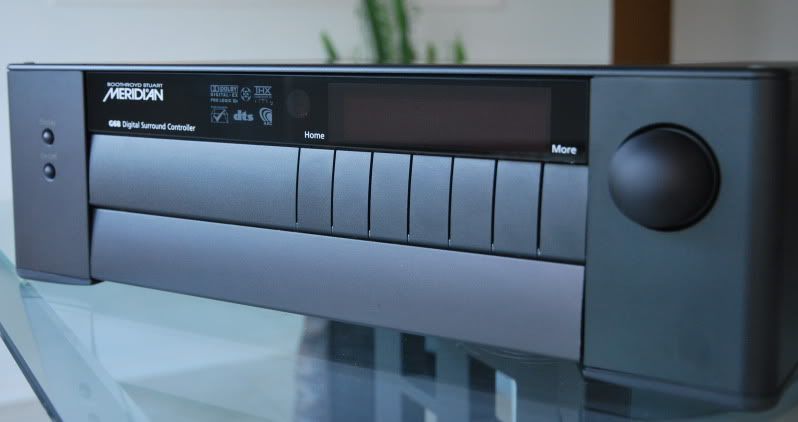Big smiles over the weekend.
I spotted a sensibly priced processor last week, and picked it up on Sat.
The new one is a Meridian G68ADV, and replaces a Meridian 568.2mm.
Sources are PS3, Xbox and a Pioneer BDP via a Meridian HD621.
Amps unchanged, Bel Canto Evo2 on the front, Rotel on the rear. I'm running 4 channels at the moment as I've yet to come across a centre good enough to match with my stereo speakers. I'm now considering a sub, but as my speakers already make it down to the mid-20s, not sure how much that will add.
As for the G68, it looks like this:

The rear is absolutely covered in inputs and outputs, so no issues on that score.
Unfortunately it doesn't have balanced connections, which is a minor issue, but seemingly not the end of the world.
Setup was "interesting". Meridian have a complex PC based application for configuration and I'm guessing that it's taken a good 4 hours to get it mostly up and running. So I now have music and my AV sources all playing fine. Just looking to get the room correction in place. For that, the recommedations seem to be to use a 3rd party product like REW to measure, then manually set filters to achieve exactly what you want, as against allowing an automated system to bugger it up.
As for SQ, I think it is an improvement on the 568.2mm, if not massive. The key thing being that it achieves that, and THEN adds room correction.
Very happy bunny.
I spotted a sensibly priced processor last week, and picked it up on Sat.
The new one is a Meridian G68ADV, and replaces a Meridian 568.2mm.
Sources are PS3, Xbox and a Pioneer BDP via a Meridian HD621.
Amps unchanged, Bel Canto Evo2 on the front, Rotel on the rear. I'm running 4 channels at the moment as I've yet to come across a centre good enough to match with my stereo speakers. I'm now considering a sub, but as my speakers already make it down to the mid-20s, not sure how much that will add.
As for the G68, it looks like this:

The rear is absolutely covered in inputs and outputs, so no issues on that score.
Unfortunately it doesn't have balanced connections, which is a minor issue, but seemingly not the end of the world.
Setup was "interesting". Meridian have a complex PC based application for configuration and I'm guessing that it's taken a good 4 hours to get it mostly up and running. So I now have music and my AV sources all playing fine. Just looking to get the room correction in place. For that, the recommedations seem to be to use a 3rd party product like REW to measure, then manually set filters to achieve exactly what you want, as against allowing an automated system to bugger it up.
As for SQ, I think it is an improvement on the 568.2mm, if not massive. The key thing being that it achieves that, and THEN adds room correction.
Very happy bunny.



